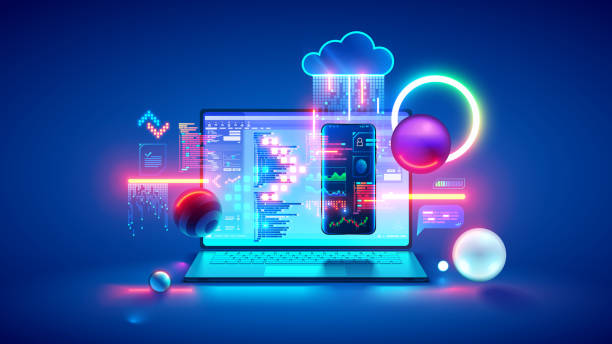The software industry stands on the threshold of one of the most transformative eras in its history. Over the last five decades, software has evolved from static, rule-based systems into dynamic, intelligent ecosystems that increasingly mirror human cognition. The next generation of software will not merely automate human processes—it will collaborate with people, adapt to environments, and make decisions independently. This evolution is being driven by advances in artificial intelligence, machine learning, quantum computing, automation, and next-generation connectivity. The convergence of these technologies is propelling us toward an era where software is not just a tool but a form of synthetic intelligence—smarter, faster, and more autonomous than anything that has existed before.
The notion of software as a static artifact is rapidly fading. Instead, software is becoming self-learning, context-aware, and capable of evolution over time. The lines between code, data, and intelligence are blurring as models learn directly from real-world feedback and adjust themselves dynamically. The result will be a new class of systems that design, optimize, and manage themselves. To understand this shift, we must explore the technological, philosophical, and societal forces that are reshaping what software means in the twenty-first century.
The Evolution of Software Intelligence
Software began as a purely procedural construct. Early programs consisted of explicit instructions that followed deterministic paths: given an input, they produced a fixed output. The limitations of such systems were clear—they could not adapt to change, context, or uncertainty. As computing power grew, software engineers developed more sophisticated paradigms, including object-oriented programming, modular design, and networked architectures. These innovations allowed software to become more flexible, scalable, and reusable, but they still relied on human-defined logic.
The real revolution began with the introduction of machine learning. Instead of being programmed with rules, systems began to learn patterns from data. Algorithms like neural networks, decision trees, and support vector machines marked the beginning of a new paradigm in which software could infer, predict, and optimize based on experience. This shift transformed industries—from recommendation systems in e-commerce to diagnostic algorithms in healthcare.
Today, with large language models, multimodal AI, and reinforcement learning, software is crossing the boundary from automation to autonomy. Models like GPT, LLaMA, and Mistral can interpret human language, write code, solve problems, and even reason about novel situations. AI-driven agents can now design and deploy other software systems, test them automatically, and update themselves in real time. The essence of software intelligence is no longer about execution—it is about evolution.
The Rise of Autonomous Systems
Autonomous software is designed to operate independently, making decisions and adapting without explicit human input. The foundations of autonomy lie in artificial intelligence, but the concept extends beyond algorithms to encompass architecture, interaction, and ethics. Autonomous systems integrate sensing, reasoning, and action in closed feedback loops. They can perceive their environments, make choices based on probabilistic reasoning, and refine their behavior through continuous learning.
In the physical world, this manifests in self-driving vehicles, autonomous drones, and robotic manufacturing. In the digital domain, it appears as self-managing infrastructure, adaptive cybersecurity systems, and self-optimizing enterprise applications. These systems are capable of understanding intent, predicting needs, and taking initiative. For example, future enterprise resource planning (ERP) systems may autonomously reallocate resources based on market fluctuations, or cybersecurity software may identify and neutralize threats before human analysts detect them.
The key to true autonomy is continuous adaptation. Traditional software systems degrade over time as they encounter scenarios beyond their design. Autonomous software, in contrast, grows more capable with experience. Reinforcement learning enables it to optimize through trial and error, while self-supervised learning allows it to generalize from massive datasets without manual labeling. This continuous evolution ensures that autonomous systems remain relevant even in unpredictable environments.
Hyperautomation and Self-Improving Infrastructure
Automation has always been a cornerstone of software development. Yet, we are now entering an era of hyperautomation—where not only are tasks automated, but the processes that enable automation are automated themselves. Hyperautomation combines artificial intelligence, robotic process automation, natural language understanding, and data analytics to orchestrate complex workflows that require minimal human oversight.
In this future, software systems will not only execute commands but also discover inefficiencies, propose optimizations, and implement improvements. Infrastructure as Code (IaC) will evolve into Infrastructure as Intelligence, where systems deploy, configure, and monitor themselves dynamically based on operational conditions. Cloud platforms will use predictive scaling and self-healing mechanisms that adapt automatically to demand.
Imagine a software ecosystem that continuously monitors application performance, predicts bottlenecks, and rewrites its code to improve efficiency. Such self-improving infrastructure will be driven by autonomous DevOps—sometimes referred to as AIOps—where machine learning models analyze telemetry data, detect anomalies, and adjust systems proactively. This will minimize downtime, optimize costs, and accelerate innovation cycles.
The Fusion of AI and Software Engineering
Artificial intelligence is not merely an application layer in modern software—it is becoming the fabric of software itself. The boundaries between coding and learning are dissolving as AI begins to play an active role in the software development lifecycle. AI-assisted development tools such as GitHub Copilot, Tabnine, and OpenAI Codex are early glimpses into a future where machines participate in writing code collaboratively with humans.
In the next decade, software engineering will be augmented by fully autonomous coding agents capable of understanding specifications, generating architecture, writing optimized code, testing it, and deploying it seamlessly. These agents will function like intelligent teammates, capable of reasoning about constraints, trade-offs, and design patterns. Developers will move from writing detailed code to expressing intent in natural language or high-level logic.
The concept of “self-developing software” is already emerging. Large-scale models trained on code repositories can infer complex software patterns and generate systems that generalize beyond specific examples. Combined with reinforcement learning from user feedback, these systems can evolve their own architectures over time. The result is a symbiosis between human creativity and machine precision—a future where programming becomes less about syntax and more about strategy and imagination.
Natural Interfaces and Cognitive Collaboration
The interface between humans and software is undergoing a profound transformation. For decades, interaction has been limited to screens, keyboards, and structured inputs. The rise of natural language interfaces, powered by large language models, is breaking this boundary. Software is becoming conversational, contextual, and empathetic, capable of understanding human language, tone, and emotion.
This cognitive collaboration allows users to engage with software in the same way they communicate with other humans. In the workplace, intelligent assistants will act as co-workers—understanding objectives, prioritizing tasks, and managing workflows autonomously. In creative fields, AI-driven tools will co-author music, literature, and design with humans, expanding artistic possibilities.
Beyond language, multimodal AI is enabling software to perceive and respond through multiple sensory channels. Systems that integrate vision, speech, and touch can interpret complex contexts and deliver richer interactions. For example, an autonomous design assistant could analyze a user’s facial expressions to gauge satisfaction and adjust its recommendations accordingly. The future of user experience will be defined not by graphical interfaces but by fluid, adaptive, and human-like interactions.
Edge Intelligence and Distributed Autonomy
As computing moves closer to where data is generated, the edge is becoming the new frontier of intelligent software. Edge computing enables real-time decision-making by processing data locally on devices or nearby servers rather than relying solely on centralized clouds. This architecture is essential for applications that require low latency, high reliability, or data privacy—such as autonomous vehicles, industrial IoT, and smart cities.
The next generation of software will be both decentralized and autonomous. Instead of a single centralized model controlling the system, distributed networks of intelligent agents will collaborate to achieve collective goals. Each agent will process local information, share insights, and coordinate with others through federated learning and swarm intelligence.
In practice, this means a fleet of delivery drones could coordinate routes dynamically based on changing conditions, or a network of healthcare sensors could detect population-level health patterns without compromising individual privacy. Distributed autonomy enhances resilience by eliminating single points of failure and democratizing intelligence across the system.
The Role of Quantum Computing in Software Evolution
Quantum computing represents another frontier that will redefine the limits of software performance and complexity. Unlike classical computers that process information in binary states, quantum computers use qubits capable of representing multiple states simultaneously through superposition. This parallelism allows them to solve certain classes of problems exponentially faster than traditional systems.
Software designed for quantum architectures must embrace fundamentally new paradigms. Instead of deterministic algorithms, developers will design probabilistic models that exploit quantum entanglement and interference. Quantum machine learning will accelerate optimization, cryptography, and simulation, enabling breakthroughs in materials science, finance, and logistics.
As quantum hardware becomes more stable and scalable, hybrid quantum-classical architectures will emerge. These systems will integrate quantum processors as co-processors within conventional infrastructures, offloading specific computations for speed and efficiency. Quantum-inspired algorithms will influence classical software as well, driving innovation in optimization and neural network training. The future of software engineering will therefore involve not only coding in quantum languages but also designing hybrid systems that bridge classical and quantum logic seamlessly.
Ethical and Regulatory Dimensions of Autonomous Software
As software becomes more autonomous, ethical and regulatory challenges intensify. When systems make independent decisions, accountability becomes diffuse. Who is responsible if an autonomous financial trading algorithm causes a market crash, or if an AI medical assistant provides harmful advice? Ensuring transparency, fairness, and safety in autonomous systems is a pressing concern for governments, developers, and society at large.
Ethical AI frameworks emphasize explainability, auditability, and bias mitigation. Future software must be designed with interpretability built into its architecture, allowing users to understand the reasoning behind decisions. Regulatory frameworks such as the EU AI Act and emerging global standards will require systems to meet stringent transparency and data protection criteria before deployment.
Autonomous systems must also be aligned with human values. Value alignment—ensuring that machine objectives match human ethics—is one of the central challenges of AI safety. This will require multi-layered oversight combining technical, legal, and philosophical approaches. Trustworthy software will need to be not only intelligent but also moral, respecting privacy, consent, and societal norms.
Security in a World of Self-Operating Systems
As software becomes more intelligent, its attack surface expands. Traditional cybersecurity approaches that rely on static rules and human intervention cannot keep pace with autonomous threats. The future of software security lies in adaptive, self-defending systems that can detect, predict, and neutralize attacks in real time.
AI-driven cybersecurity leverages anomaly detection, behavioral modeling, and predictive analytics to identify threats before they cause damage. Autonomous security agents will monitor networks continuously, share intelligence across distributed systems, and coordinate defenses dynamically. These agents will be capable of responding to zero-day exploits by patching vulnerabilities automatically, much like a biological immune system responding to infection.
In the coming years, we will see the rise of adversarial AI, where intelligent systems battle each other—attackers developing adaptive malware and defenders deploying self-learning countermeasures. This will usher in an era of cyber resilience, where security evolves continuously rather than being implemented as a static safeguard. Ensuring that autonomous systems remain secure will be as important as making them intelligent.
The Acceleration of Development Cycles
Traditional software development lifecycles—requirements, design, coding, testing, deployment—are giving way to continuous and autonomous pipelines. With AI-driven tools, software can now evolve at the pace of data. DevOps has evolved into MLOps and AIOps, integrating machine learning directly into the feedback loop of development and operations.
In this environment, software updates will occur autonomously, often in real time. Systems will monitor their performance, detect bottlenecks, and self-correct without waiting for human intervention. The feedback loop between usage and improvement will shorten dramatically, enabling software to evolve continuously.
The acceleration of development also transforms the economics of software production. Automated code generation, testing, and optimization will reduce time-to-market, lower maintenance costs, and enable hyper-personalized products. Businesses will shift from software releases to living platforms that adapt to users continuously.
The Convergence of Software and Biology
A fascinating dimension of the future of software lies in its convergence with biology. Biological systems exhibit characteristics that software designers strive to emulate—adaptability, resilience, self-repair, and emergent intelligence. The fields of bioinformatics, synthetic biology, and computational neuroscience are increasingly intertwined with software engineering.
Neuro-symbolic AI, inspired by the human brain’s integration of reasoning and pattern recognition, is one pathway toward more human-like cognition in software. Meanwhile, biological computing—using DNA or cellular systems for computation—could redefine the physical substrate of software altogether. In this paradigm, code is not just digital but organic, capable of replication and mutation.
The fusion of biology and software may also manifest in interfaces between human neural systems and artificial intelligence. Brain-computer interfaces (BCIs) will allow direct communication between thought and software, blurring the boundary between user and system. As cognitive augmentation becomes reality, software will not only serve human needs but become an extension of human consciousness itself.
Environmental Sustainability and Green Software
As the computational demands of AI and autonomous systems grow, the environmental impact of software development and operation becomes a major concern. Data centers, training large models, and continuous connectivity consume vast amounts of energy. The future of software must therefore also be sustainable.
Green software engineering focuses on optimizing energy efficiency across the entire lifecycle of applications—from code execution to hardware utilization. Techniques such as model pruning, quantization, and edge processing can dramatically reduce energy consumption. Cloud providers are increasingly adopting renewable energy sources and carbon-aware scheduling to minimize environmental impact.
In the near future, autonomous systems will manage their own sustainability footprints, optimizing for energy efficiency alongside performance. Software will monitor its power usage and adaptively balance workloads between regions or devices based on renewable energy availability. Sustainability will become a design principle as fundamental as reliability or security.
The Economic and Social Impact of Autonomous Software
The rise of autonomous software will reshape global economies and labor markets. Routine cognitive tasks—such as data analysis, customer support, and administrative work—will be increasingly handled by intelligent systems. This will free human workers to focus on creativity, strategy, and innovation. However, it also raises concerns about displacement, skill gaps, and economic inequality.
To navigate this transition, societies will need to reimagine education, emphasizing creativity, ethics, and interdisciplinary thinking over rote technical skills. Collaboration between humans and intelligent systems will become the new norm, where humans provide context and judgment while machines provide scale and precision.
Economically, autonomous software will accelerate productivity and innovation across sectors. New industries will emerge around AI governance, synthetic data generation, autonomous infrastructure, and digital ethics. The capacity for software to manage itself will lower barriers to entrepreneurship, allowing smaller teams to build complex systems at global scale. The resulting acceleration in innovation could rival the industrial revolution in its societal impact.
Human-Centric Design in an Autonomous Age
Despite the growing independence of software, its ultimate purpose remains to serve human needs. The future of software design will therefore focus on human-centricity—creating systems that enhance well-being, empowerment, and trust. Human-computer interaction will evolve into human-computer symbiosis, emphasizing collaboration rather than control.
Designers will need to embed empathy and context-awareness into systems. Future interfaces will adapt not only to user commands but also to user emotions, habits, and goals. Ethical design will prioritize transparency, inclusivity, and accessibility to ensure that autonomous technologies serve everyone, not just the technologically privileged.
Human oversight will remain essential, even in self-operating systems. The challenge is to balance autonomy with accountability—to build systems that make intelligent decisions while respecting human authority. This requires not only technical safeguards but also cultural and philosophical frameworks that define the role of humanity in an increasingly autonomous digital world.
The Convergence of the Physical and Digital Worlds
The boundary between software and the physical world is dissolving. The Internet of Things, robotics, and digital twins are creating a seamless continuum where digital intelligence governs physical reality. In manufacturing, digital twins—virtual replicas of physical systems—allow continuous monitoring, prediction, and optimization of production processes. In urban environments, smart infrastructure integrates real-time data to manage traffic, energy, and resources autonomously.
The fusion of physical and digital domains will give rise to what some call the “programmable world.” Buildings, vehicles, and even biological systems will be embedded with sensors and actuators controlled by intelligent software. This will enable environments that adapt to human presence dynamically, optimizing comfort, efficiency, and sustainability.
In such a world, software becomes the invisible infrastructure of daily life. Its presence will be ubiquitous yet seamless, enabling experiences that feel natural and intuitive. The challenge will lie in ensuring that this pervasive intelligence remains secure, ethical, and aligned with human values.
The Role of Open Source and Collective Innovation
The future of software will also be shaped by the open-source movement, which democratizes access to technology and accelerates collective innovation. Open-source LLMs like LLaMA and Mistral, and frameworks like PyTorch and TensorFlow, have empowered millions of developers to build upon shared foundations. This collaborative model will be critical for ensuring transparency, accountability, and inclusivity in the age of autonomous software.
Community-driven development encourages diversity of thought, peer review, and shared ethical responsibility. Open ecosystems foster interoperability and prevent monopolization of intelligence by a few corporations. In the coming years, open-source platforms will host not only code but also datasets, models, and autonomous agents, enabling collaborative evolution of digital intelligence.
Open collaboration will also extend to governance. Decentralized autonomous organizations (DAOs) may play a role in managing software ecosystems, where policies and upgrades are determined collectively by users and developers. This democratized form of innovation could ensure that the benefits of intelligent software are distributed broadly across society.
A Vision for the Next Decade
As we look toward the coming decade, the trajectory of software points unmistakably toward greater intelligence, speed, and autonomy. Software will cease to be a passive executor of human commands and become an active partner in creativity, decision-making, and problem-solving. The convergence of AI, quantum computing, automation, and human-machine collaboration will redefine industries and reshape human life.
Yet, this future also demands humility. Intelligence, whether biological or artificial, carries moral and existential weight. The more autonomy we grant to machines, the greater our responsibility to ensure they act in alignment with human values and the common good. The true measure of progress will not be how smart software becomes, but how wisely we use it.
The future of software is not just technological—it is philosophical. It challenges us to reconsider what it means to create, to decide, and to exist alongside entities that can learn and reason. In the decades to come, software will not only transform how we work and live—it will redefine what it means to be human in a world of intelligent machines.
Conclusion
The software of the future will be a living, evolving entity—smarter, faster, and more autonomous than anything we have known. It will bridge the digital and physical worlds, blend human and machine intelligence, and reshape the foundations of society. The convergence of AI, automation, and human creativity will yield systems that not only execute tasks but understand purpose.
As these systems emerge, our greatest challenge will be to ensure they reflect our highest aspirations rather than our lowest impulses. The path forward lies in responsible innovation, ethical design, and a shared vision of progress. The future of software is not merely about code—it is about consciousness, collaboration, and the enduring pursuit of intelligence in service of humanity.






